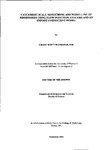CATCHMENT SCALE MONITORING AND MODELLING OF PHOSPHORUS USING FLOW INJECTION ANALYSIS AND AN EXPORT COEFFICIENT MODEL
| dc.contributor.author | HANRAHAN, GRADY SCOTT | |
| dc.contributor.other | Faculty of Science and Engineering | en_US |
| dc.date.accessioned | 2013-09-17T09:39:16Z | |
| dc.date.available | 2013-09-17T09:39:16Z | |
| dc.date.issued | 2001 | |
| dc.identifier | NOT AVAILABLE | en_US |
| dc.identifier.uri | http://hdl.handle.net/10026.1/1776 | |
| dc.description.abstract |
Acquiring high quality in situ analytical data with good temporal resolution is required for developing models of phosphorus transport and biogeochemical behaviour. Chapter One describes the behaviour of phosphorus in the aquatic environment, its sources, its role in the eutrophication process and legislation to control its release into aquatic systems. It also summarises analytical techniques for the determination of phosphorus in natural waters. An examination of the hypothesis that the export coefficient modelling approach can be used to predict phosphorus loading in the River Frome catchment, Dorset on an armual and seasonal (monthly) basis is presented in Chapter Two. The model predicted an annual (1998) phosphorus load of 25,605 kg yr'\ compared with an observed (measured) value of 23,400 kg yr'V Monthly loads agreed well with monthly observed values except during months of variable discharge. Chapter Three describes a study on the comparison of sample storage protocols for the determination of total oxidised nitrogen (TON) and filterable reactive phosphorus (FRP) in the River Frome and Tamar Estuary. The results showed that optimum storage conditions were highly matrix dependent, with significant differences in measured FRP concentration over time between the River Frome and Tamar Estuary (due to different calcium concentrations) and between samples of different salinities (due to different bacterial populations). Chapter Four describes the development and deployment of a portable flow injection (FI) monitor for phosphorus determination in the River Frome. The automated monitor, incorporating solenoid micropumps and switching valves, a miniature CCD spectrometer, a graphical programming environment and a tangential flow filtration unit, achieved a detection limit of 0.67 pM and was able to monitor at high temporal resolution (every 30 min). Chapter Five examines historical water quality indicators and data fi-om recent shortterm, high temporal monitoring campaigns using the FI monitor in order to identify the key factors affecting phosphorus concentrations in the River Frome. Results showed the importance of catchment geology (chalk-based) and hydrological conditions in relation to other physico-chemical parameters in controlling phosphorus behaviour. | en_US |
| dc.description.sponsorship | Centre for Ecology & Hydrology, Dorset, UK | en_US |
| dc.language.iso | en | en_US |
| dc.publisher | University of Plymouth | en_US |
| dc.title | CATCHMENT SCALE MONITORING AND MODELLING OF PHOSPHORUS USING FLOW INJECTION ANALYSIS AND AN EXPORT COEFFICIENT MODEL | en_US |
| dc.type | Thesis | |
| plymouth.version | Full version | en_US |
| dc.identifier.doi | http://dx.doi.org/10.24382/4693 |
Files in this item
This item appears in the following Collection(s)
-
01 Research Theses Main Collection
Research Theses Main


